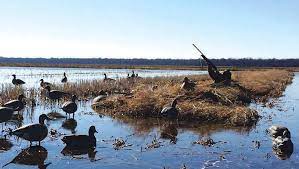
Duck hunters are bemoaning the fact that ducks are not returning to where they used to come. Why? Because the land is no longer there.
Ryan Lambert and his crew had their eyes glued to the radar as rain poured relentlessly in the early hours of the morning. They waited in his Buras lodge, searching for a break. Finally, the storm moved on, though the dim, overcast skies loomed overhead. The rain had bought his guests a few extra hours of sleep — not that they wanted it in the last week of duck hunting season in late January. Clad in thick, camouflage jackets and waist-high waders, the group of more than a dozen hunters waddled to their trucks, anxious to bag their prey. After a boat ride across the Mississippi River, the group took a floating duck blind into the marshes lining the east bank of lower Plaquemines Parish. Lambert docked and companions Martha Spencer and Sarah Giles set the trap. Palm fronds camouflaged and obscured the blind while bobbing decoy ducks created an inviting scene. They lowered themselves into the blind, guns ready to fire. Nothing came.
wwno.org
Rising seas and the effects of climate change are changing the geography, and not for the good.
As southern Louisiana’s vast wetlands succumb to the effects of rising seas and a cascade of other environmental changes, hunters are seeing their quarry dwindle. “The consensus around Louisiana is the duck season’s been pretty dismal,” Giles said, her shotgun leaning against her shoulder. Lambert, a 64-year-old charter guide who’s hunted in Plaquemines for decades, has watched the number of good duck days dwindle over the years, attributed in part to the loss of more than 430 square miles of wetland habitat in the region. “If there’s nothing for them to eat, they can’t stay, plain and simple,” he said, between duck calls. “They come and check it out. But if there’s no food, they got to go.” As sea rise accelerates and the geologically young land across south Louisiana continues to sink, a Climate Central analysis shows no other state in the Lower 48 faces greater threats of wetland losses during the decades ahead, followed by North Carolina and Texas. Plaquemines Parish alone could lose 100,000 more acres of wetlands than it gains by the end of the century. Because marshland can migrate inland as seas rise, conserving upland areas and minimizing property development there can reduce wetland losses. Rising temperatures are also spurring stronger tropical storms in the Gulf region as the natural buffer provided by wetlands weakens.
We, sadly, are not alone as in other parts of the country the same thing is happening.
As in other parts of the country, hunters and anglers are acutely aware of the changes. Surveys and focus groups with these outdoors people conducted by the Theodore Roosevelt Conservation Partnership showed that most understand the role of global warming in the changes underway, while 86% supported conservation and restoration efforts, according to Tiffany Turner, director of Climate Solutions at the nonprofit. With less habitat, hunters and other waterfowl experts say there are fewer ducks flocking to Louisiana, especially the all-American mallard and pintail as marsh converts to open water and the climate warms to the north. In fact, a 2020 study by Gulf Coast Joint Venture, a partnership between Ducks Unlimited and government agencies, found that Louisiana’s coast can support 3 million fewer ducks due to the ongoing habitat loss than it could in the 1970s. Duck hunters have already been forced to adapt to changing conditions and find different hunting grounds from their childhood. In the future, that’s only expected to grow harder in what many consider to be Sportsman’s Paradise, stirring concerns over the potential loss of a key piece of Louisiana culture.
Duck hunting is a family affair.
Preston St. Romain wasn’t old enough to remember his first trip to the duck blind. He was just 18 months old, watching his family hunt from a car seat. Now, at 38, he’s one of Louisiana’s 53,800 duck hunters. Like many generations before him, he spends much of his time from November through January in the marshes of Cameron Parish, listening for the sound of beating wings. Millions of ducks flock to warmer states like Louisiana every winter, fleeing the harsh cold in northern states. It’s that annual migration that has made the state, especially along the coast, a boon for sportsmen, bagging more ducks than most of the country. Every year, St. Romain’s family spends the day after Christmas on the hunt. Between his father, brother and five sons, there are three generations piled into one blind. “It’s a lot more than the kill for us,” he said. “I love taking them out, watching them and I think I’m experiencing the same joy that my dad had taking us.” There’s also an art to the hunt that many spend years mastering. For decades, Lambert honed his ability to lure birds with his duck calls that vary from species to species. Flocks will change directions in response to his feeding calls, making it easier for his fellow hunters to go in for the kill. “It’s so entrenched in our heritage in Louisiana, it’s incredible,” Lambert said. Like many longtime hunters, he remembers days when the skies would darken with ducks. One hunt, Lambert said he called so many in that his father dropped his gun and started batting ducks out of the air with his cane.
Not so much today but there are still ducks to hunt.
St. Romain heard similar stories from his grandfather, and even remembers times in his own childhood when ducks were more plentiful than they are today. “I was telling my kids not long ago, a year or two ago, when we were in the duck blind, I said, ‘You know, boys, y’all will never have the opportunity to see what I saw as a kid,” St. Romain said. Though Louisiana hunters still bag more ducks than most of the rest of country, their success and satisfaction have decreased. It’s not just that there are far fewer ducks to shoot — they’re also grappling with shifts in species available for them to hunt. Diver ducks like scaups and canvasbacks that prefer open waters are now more abundant than dabbler ducks like teals, mallards, and mottled ducks that typically use shallow waters, marshes and pools. When it comes to diver ducks, “for a lot of hunters — they’ll shoot them if they’re there,” said Jason Olszak, Louisiana Department of Wildlife and Fisheries’ Waterfowl Program manager. But they’d prefer to shoot the dabbler species, whose numbers are declining significantly, he said, as coastal wetlands disappear. As per Lambert and Giles, the 2021-22 hunting season was one of the worst in recent history. With each challenging season, more hunters leave the sport. According to annual reports by the Louisiana Department of Wildlife and Fisheries, the number of duck hunters has almost halved since the 2012-13 season. “If people don’t have a good season, a lot of them just won’t hunt the next year … or they go somewhere else,” Giles said. “You lose more hunters, and they’re the best advocates for conservation.”
It is only to get worse as pollution causes more land loss.
As pollution continues to trap heat and raise sea levels, the trends are poised to accelerate. Between 1932 and 2016, Louisiana lost about 25% of its coastal wetlands, but that rate of loss slowed down since the mid-1970s. Still, every 100 minutes, a football field’s worth of coastal wetlands vanish into the open water thanks to the levees built to ward off flooding, dredged canals that bring in saltwater and destroy the vegetation, sinking land, and rising global sea levels. “Sea level rise is the thing that scares me the most because it hasn’t been something that we’ve been dealing with thus far,” said University of New Orleans professor Madeline Foster-Martinez. She studies Louisiana’s coast and leads the college’s Coastal Interactions Lab. Wetlands can only keep pace with so much sea level rise at a time, she said. By 2100, as global temperatures continue to increase, a predicted four-foot rise in sea levels could submerge large parts of Louisiana’s remaining coastal wetlands, unless they accrue sediment and grow vertically or migrate inland into undeveloped areas. Even with moderate cuts to global greenhouse gas emissions, Climate Central researchers found that the state could lose almost all of its coastal wetlands by the end of the century, though losses would be lessened if adjoining dry lands are conserved for these marshy habitats to migrate into. Ultimately, the future of the coastal wetlands — and the ducks and other wildlife that rely on them — will depend on how much greenhouse gas pollution is released as well as whether land is set aside for them to move into. “The uncertainty in those [sea level rise] projections are very tied to our emissions scenarios,” she said. “That’s something that I always try to emphasize, that your everyday actions for carbon emissions and contributing to climate change, they do relate to our coast because of sea level rise.”
What can we do and what is being done now?
Although Louisiana’s coast will not return to its former glory, state agencies, conservation groups and local hunters like Lambert are trying to grow and sustain a smaller one. Ducks Unlimited, a national group dedicated to waterfowl conservation, has spent just over $612 million over the years in Louisiana, working to maintain 500,000 acres. Mike Carloss, a regional conservation programs director for the group, said they’ve begun cutting small crevasses, or cuts in river banks, to help fresh, sediment-rich water flow into marshes and build land. That’s in addition to building small levees that reduce erosion, terracing to slow water flows and other measures that benefit the broader ecosystem. “We’re looking at ducks, but they’re just a small piece of that whole big puzzle of what utilizes these natural resources,” Carloss said. Lambert himself helped construct a $750,000 project involving crevasses and terraces off Plaquemines Parish’s east bank in Bay Denesse near Quarantine Bay. Since it was completed two years ago, lush marsh grasses and submerged aquatic vegetation have returned to the area. It’s a smaller version of larger river diversion projects planned by the state in Plaquemines Parish as part of its $50 billion, 50-year coastal restoration plan. The $2 billion Mid-Barataria Sediment Diversion is currently awaiting a decision from the U.S. Army Corps of Engineers and is expected to build and maintain 21 square miles of land over the first 50 years of operation. Lambert watched his childhood fishing and hunting spots slip beneath the water’s surface, and that loss has also left his community more vulnerable to hurricanes that are growing more intense. The decline of duck hunting represents a larger, existential threat that needs to be met with urgency — as evidenced by the destruction left by Hurricane Ida last summer. “You’ve got to have habitat, everything depends on that,” he said. “If we don’t, we can’t live here either.”
This being Louisiana, I bet most of the hunters are republicans and they may be the ones that can be brought to the environmental side.



